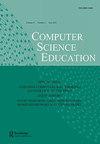Assessing computational thinking: an overview of the field
IF 2.2
Q1 EDUCATION & EDUCATIONAL RESEARCH
引用次数: 13
Abstract
The last decade has seen rapid growth in the presence of computational thinking (CT) in educational contexts. Those working to advance CT argue that the concepts and skills associated with CT are essential to succeed in an increasingly computational world. As a result of these efforts, CT has a growing presence in K-12 classrooms and beyond. This can be seen in the inclusion of CT in disciplinary standards (e.g. the Next Generation Science Standards and Common Core Math identifying CT as a core practice), as well as national curricular efforts (e.g. the United Kingdom’s national computing curriculum seeks to have students “develop and apply their analytic, problem-solving, design, and computational thinking skills”). Just as CT has a growing presence in formal education, it can also be seen in informal contexts through the growth of computing camps, after-school and library CT programming, and a growing array of toys designed to engage youth with CT. The contemporary discussion around CT began with Wing’s (2006) article, where she argued “to reading, writing, and arithmetic, we should add computational thinking to every child’s analytical ability” (p. 33). However, the conceptual origins have a much longer history, dating back to early work on the Logo programming language and Papert’s insights on the potential of computing as a powerful context for learning (1980). In response to Wing’s article, much effort has been dedicated to trying to define what constitutes CT and where the boundaries of the construct lie. While the community has yet to settle on a single unified definition, there is general consensus that CT includes foundational computing concepts such as abstraction and algorithms, as well as computing practices such as problem decomposition and debugging (Grover & Pea, 2013; Shute et al., 2017). As the dust started to settle from early debates around the scope and nature of CT, a growing number of research projects sought to design CT learning experiences. Spurred in part by an increase in funding for educational projects at the intersection of computing and other disciplines, a space in which CT is particularly well-suited to contribute, the last decade has seen tremendous growth in curricula, learning environments, and innovations around CT education (Tang et al., 2020). In the wake of this growth, this special issue seeks to respond to a question of growing importance: How do we assess computational thinking? This is not a straightforward question to answer as several aspects of CT make it challenging to assess. For example, there is a wide variety of methods by which CT is taught and contexts in which students learn CT. While some schools offer stand-alone CT learning experiences, other schools may try to integrate CT within current subject matters. Further, as discussed above, CT is a relatively ill-defined construct, thus, different assessments may focus on slightly different dimensions of CT. Collectively, this produces a landscape where a variety of assessments are needed to reflect the different conceptual, contextual, and motivational aspects of CT instruction. COMPUTER SCIENCE EDUCATION 2021, VOL. 31, NO. 2, 113–116 https://doi.org/10.1080/08993408.2021.1918380评估计算思维:该领域概述
在过去的十年中,计算思维(CT)在教育环境中的存在迅速增长。那些致力于推进CT的人认为,与CT相关的概念和技能对于在日益计算机化的世界中取得成功至关重要。由于这些努力,CT在K-12及以后的课堂上越来越多地出现。这可以从将CT纳入学科标准(例如,《下一代科学标准》和《共同核心数学》将CT确定为核心实践)以及国家课程努力(例如,英国的国家计算机课程旨在让学生“发展和应用他们的分析、解决问题、设计和计算思维技能”)中看出。正如计算机辅助教育在正规教育中的应用越来越广泛一样,计算机辅助教育在非正式环境中的应用也越来越广泛,比如计算机夏令营、课后和图书馆的计算机辅助教育项目,以及旨在吸引青少年参与计算机辅助教育的各种玩具。当代关于CT的讨论始于Wing(2006)的文章,她认为“除了阅读、写作和算术,我们应该为每个孩子的分析能力增加计算思维”(第33页)。然而,概念起源的历史要长得多,可以追溯到Logo编程语言的早期工作,以及Papert对计算作为学习的强大背景的潜力的见解(1980年)。为了回应Wing的文章,很多人都在努力定义什么是CT,以及这个结构的界限在哪里。虽然社区尚未确定一个统一的定义,但普遍的共识是,CT包括基本的计算概念,如抽象和算法,以及计算实践,如问题分解和调试(Grover & Pea, 2013;Shute et al., 2017)。随着早期关于CT的范围和性质的争论尘埃落定,越来越多的研究项目寻求设计CT学习体验。在计算机和其他学科交叉的教育项目的资金增加的部分刺激下,CT特别适合在这个领域做出贡献,在过去十年中,围绕CT教育的课程、学习环境和创新都有了巨大的增长(Tang et al., 2020)。随着这种增长,本期特刊试图回答一个日益重要的问题:我们如何评估计算思维?这不是一个直截了当的问题,因为CT的几个方面使其难以评估。例如,CT的教学方法和学生学习CT的环境多种多样。虽然有些学校提供独立的CT学习体验,但其他学校可能会尝试将CT整合到当前的学科中。此外,如上所述,CT是一个相对不明确的结构,因此,不同的评估可能侧重于CT的略有不同的维度。总的来说,这产生了一种需要各种评估来反映CT教学的不同概念、背景和动机方面的景观。计算机科学教育2021,第31卷,第31期。2,113 - 116 https://doi.org/10.1080/08993408.2021.1918380
本文章由计算机程序翻译,如有差异,请以英文原文为准。
求助全文
约1分钟内获得全文
求助全文
来源期刊

Computer Science Education
EDUCATION & EDUCATIONAL RESEARCH-
CiteScore
6.90
自引率
3.70%
发文量
23
期刊介绍:
Computer Science Education publishes high-quality papers with a specific focus on teaching and learning within the computing discipline. The journal seeks novel contributions that are accessible and of interest to researchers and practitioners alike. We invite work with learners of all ages and across both classroom and out-of-classroom learning contexts.
 求助内容:
求助内容: 应助结果提醒方式:
应助结果提醒方式:


